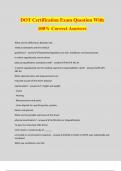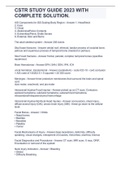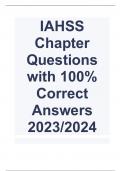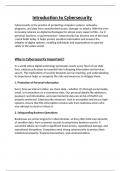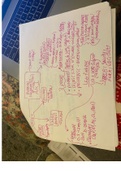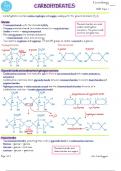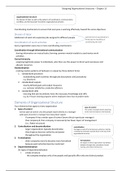Work and Performance Summary
Lecture 1
Difference between person, work and organisation (and interventions) → how course is
structured and mostly focused on
Basic principles
1. Mutual relationship between work and health
a. Bad working conditions → stress and burnout
b. Work in general has a positive influence on health
c. And if you’ve got health problems, you are less likely to work (hard)
2. Focus on person, work and organisation
a. Including focus on Occupational Health → the main focus in occupational
health is on three different objectives:
i. Person → maintenance and promotion of health (HRM, health
promotion; cure, prevention and amplition)
ii. Work → improvement working environment (occupational safety and
health OSH; job content and working conditions)
iii. Organisation → development of organisations and cultures (policy,
culture, integration of HRM and OSH)
1
,Knowledge Clips Lecture 2
There are two basic principles in this course
1. Reciprocal relationship between work and health
a. Working conditions on health and wellbeing
2. Trichotomy between person, work and organisation
a. Focus on the role of work
Theoretical models in this lecture and later on in the course → DCS, JD-R and DISC(-R)
model (later ERI, JCM and vitamin model)
Demand-Control Model, DC-model (Karasek, 1979) → distinguishes job demands and job
control → mostly focus on quantitative demands
• Job demands → e.g. work load, role problems, such as role ambiguity
• Job control → e.g. skill discretion people have (number of skills people need to use in
their jobs), decision latitude (extend to which they can decide themselves how they
do their jobs, so autonomy)
• This leads to 4 quadrants → job demands can be high and low and job control can be
high and low
o Low control + low demands = passive jobs → for example,
receptionist
o High control + high demands = active jobs → for example,
professor or medical doctor
o High control + low demands = low strain jobs → for example,
wild life photographer
o Low control + high demands = high strain jobs → for example,
nurses or waitresses
• There are two hypotheses in the Demand-Control Model
o Strain hypothesis → as job demands get higher, and job control gets lower,
strain increases in the job
o Active learning hypothesis → as job demands get higher, and job control get
higher as well, there is more active learning on the job
Demand-Control-Support Model, DCS-model (Karasek) → extension of the DC-model →
states that job demands cannot only be battled by job control but also by social support
• Strain hypothesis → high job demands can lead to high
strain, but this is especially the case when job control is
low and there is little social support at the job
o Especially combination of high demands, low
control, and weak support from colleagues is
dangerous → these jobs are iso-strain jobs → for
example, psychiatric nurse in emergency service
▪ Iso = isolated
• This model was very influential in the 80’s and 90’s of previous century
• Then in 2001, the JD-R model was introduced
2
,Job-Demand-Resources Model, JD-R model (Demerouti et al., 2001) → job demands lead to
exhaustion, whereas job resources lower disengagement
• Exhaustion and disengagement are aspects of burnout
• Job demands → all kind of characteristics of working
conditions that are negative
o E.g. physical demands, emotional demands,
mental strain, every characteristic of the job
that requires effort
• Job resources → positive characteristics that help you
perform your tasks
o E.g. autonomy, social support, appreciation, learning opportunities and salary
• There are two processes in the JD-R model (in the original model)
o Overtaxing → high job demands lead to exhaustion
o Withdrawal → low job resources lead to disengagement
The revised JD-R model (Schaufeli & Bakker, 2004)
→ there are a few differences in the models
1. Burnout as one construct, rather than two
loose ones
o Job demands increase burnout
o Job resources decrease burnout
2. Work engagement as a positive,
psychological counterpart of burnout
o Job resources increase work
engagement (later changes → job demands decrease work engagement)
3. They focus on work outcomes → e.g. health and productivity
o Job demands and job resources lead to work outcomes, through burnout and
work engagement
o So burnout and work engagement are the explanatory variables or the
mediators of the relationship of job demands and recourses on work outcomes
o There are now two new processes in the revised JD-R model
▪ Health impairment process → from job demands, through burnout, to
work outcomes
▪ Motivational process → from job resources, through engagement, to
work outcomes
4. Other changes have been made over time
o Job demands may change work
engagement as well
▪ Positively (workload leads to
more work engagement =
challenges) and negatively
(hindrances)
o Job demands and resources interact
▪ Job resources may act as a
buffer on the negative effects of
job demands
▪ High job demands may
strengthen the positive effects of job resources → workload is high and
work may motivate you when you have enough resources to do your
job
3
, 5. Incorporation of personal resources →
characteristics of individual that hep them to
carry out their tasks → e.g. high self-esteem,
resilience, self-efficacy, optimism
o Personal resources directly affects
stress-reactions (burnout) and
wellbeing (work engagement)
o PR may moderate → for optimistic
people, job demands may have less
effect on burnout, as to pessimists
o PR may mediate → autonomy and an
acceptable workload may lead to
higher self-efficacy which
subsequently leads to less burnout
and more work engagement
o PR may influence job demands and resources → optimistic people may seem
workload as a challenge, rather than an hinderance, or may interpret their
colleagues actions as supportive, rather than undermining
o PR may be a confounder → emotional stability may influence all job demands
and resources, but also burnout and work engagement → as a result of which,
relationships between these variables are spurious/false/deceptive
Relevance for practice of JD-R model → how can you apply is such that you can examine or
improve a work situation?
• Each job has its own constellation of demands and resources → you should examine
these job demands and resources and in the next step, try to improve the job by
changing job demands, job resources or the balance between them
• Burnout and work engagement explain how job demands and resources influence job
outcomes → you should consider mild burnout complaints and low work engagement
as early warning system for actual burnout
o Try out whether you can lower hindrances, increase challenges, increase
resources (social support, autonomy) to increase motivation and wellbeing
DISC-Model (De Jonge & Dormann, 2003) → Demand-Induced-Strain-Compensation Model
→ means that job demands induce strain → which can be compensated for, by job resources
• Two principles in the DISC-model
o Multidimensionality of job demands and resources → cognitive, emotional and
physical → also called, the head, hearth and hand
o Matching principle → strongest health effects when demands and resources
are matched → both cognitive, emotional of physical
▪ Triple match hypothesis → demands, resources and outcomes are on
similar dimensions, so all three cognitive, emotional of physical
• In expansion of the model, recovery is added → DISC-R model → counter act high
demands, better balance
o Restoring internal resources → e.g. mini breaks during work, good night
sleep, resting, activities during weekends, holidays
o Detachment → a way to distance oneself from work
▪ According to DISC-R model → detachment most effective if it matches
the dimension demands (emotional detachment to reduce emotional
exhaustion with as a result of emotional demands)
4
Lecture 1
Difference between person, work and organisation (and interventions) → how course is
structured and mostly focused on
Basic principles
1. Mutual relationship between work and health
a. Bad working conditions → stress and burnout
b. Work in general has a positive influence on health
c. And if you’ve got health problems, you are less likely to work (hard)
2. Focus on person, work and organisation
a. Including focus on Occupational Health → the main focus in occupational
health is on three different objectives:
i. Person → maintenance and promotion of health (HRM, health
promotion; cure, prevention and amplition)
ii. Work → improvement working environment (occupational safety and
health OSH; job content and working conditions)
iii. Organisation → development of organisations and cultures (policy,
culture, integration of HRM and OSH)
1
,Knowledge Clips Lecture 2
There are two basic principles in this course
1. Reciprocal relationship between work and health
a. Working conditions on health and wellbeing
2. Trichotomy between person, work and organisation
a. Focus on the role of work
Theoretical models in this lecture and later on in the course → DCS, JD-R and DISC(-R)
model (later ERI, JCM and vitamin model)
Demand-Control Model, DC-model (Karasek, 1979) → distinguishes job demands and job
control → mostly focus on quantitative demands
• Job demands → e.g. work load, role problems, such as role ambiguity
• Job control → e.g. skill discretion people have (number of skills people need to use in
their jobs), decision latitude (extend to which they can decide themselves how they
do their jobs, so autonomy)
• This leads to 4 quadrants → job demands can be high and low and job control can be
high and low
o Low control + low demands = passive jobs → for example,
receptionist
o High control + high demands = active jobs → for example,
professor or medical doctor
o High control + low demands = low strain jobs → for example,
wild life photographer
o Low control + high demands = high strain jobs → for example,
nurses or waitresses
• There are two hypotheses in the Demand-Control Model
o Strain hypothesis → as job demands get higher, and job control gets lower,
strain increases in the job
o Active learning hypothesis → as job demands get higher, and job control get
higher as well, there is more active learning on the job
Demand-Control-Support Model, DCS-model (Karasek) → extension of the DC-model →
states that job demands cannot only be battled by job control but also by social support
• Strain hypothesis → high job demands can lead to high
strain, but this is especially the case when job control is
low and there is little social support at the job
o Especially combination of high demands, low
control, and weak support from colleagues is
dangerous → these jobs are iso-strain jobs → for
example, psychiatric nurse in emergency service
▪ Iso = isolated
• This model was very influential in the 80’s and 90’s of previous century
• Then in 2001, the JD-R model was introduced
2
,Job-Demand-Resources Model, JD-R model (Demerouti et al., 2001) → job demands lead to
exhaustion, whereas job resources lower disengagement
• Exhaustion and disengagement are aspects of burnout
• Job demands → all kind of characteristics of working
conditions that are negative
o E.g. physical demands, emotional demands,
mental strain, every characteristic of the job
that requires effort
• Job resources → positive characteristics that help you
perform your tasks
o E.g. autonomy, social support, appreciation, learning opportunities and salary
• There are two processes in the JD-R model (in the original model)
o Overtaxing → high job demands lead to exhaustion
o Withdrawal → low job resources lead to disengagement
The revised JD-R model (Schaufeli & Bakker, 2004)
→ there are a few differences in the models
1. Burnout as one construct, rather than two
loose ones
o Job demands increase burnout
o Job resources decrease burnout
2. Work engagement as a positive,
psychological counterpart of burnout
o Job resources increase work
engagement (later changes → job demands decrease work engagement)
3. They focus on work outcomes → e.g. health and productivity
o Job demands and job resources lead to work outcomes, through burnout and
work engagement
o So burnout and work engagement are the explanatory variables or the
mediators of the relationship of job demands and recourses on work outcomes
o There are now two new processes in the revised JD-R model
▪ Health impairment process → from job demands, through burnout, to
work outcomes
▪ Motivational process → from job resources, through engagement, to
work outcomes
4. Other changes have been made over time
o Job demands may change work
engagement as well
▪ Positively (workload leads to
more work engagement =
challenges) and negatively
(hindrances)
o Job demands and resources interact
▪ Job resources may act as a
buffer on the negative effects of
job demands
▪ High job demands may
strengthen the positive effects of job resources → workload is high and
work may motivate you when you have enough resources to do your
job
3
, 5. Incorporation of personal resources →
characteristics of individual that hep them to
carry out their tasks → e.g. high self-esteem,
resilience, self-efficacy, optimism
o Personal resources directly affects
stress-reactions (burnout) and
wellbeing (work engagement)
o PR may moderate → for optimistic
people, job demands may have less
effect on burnout, as to pessimists
o PR may mediate → autonomy and an
acceptable workload may lead to
higher self-efficacy which
subsequently leads to less burnout
and more work engagement
o PR may influence job demands and resources → optimistic people may seem
workload as a challenge, rather than an hinderance, or may interpret their
colleagues actions as supportive, rather than undermining
o PR may be a confounder → emotional stability may influence all job demands
and resources, but also burnout and work engagement → as a result of which,
relationships between these variables are spurious/false/deceptive
Relevance for practice of JD-R model → how can you apply is such that you can examine or
improve a work situation?
• Each job has its own constellation of demands and resources → you should examine
these job demands and resources and in the next step, try to improve the job by
changing job demands, job resources or the balance between them
• Burnout and work engagement explain how job demands and resources influence job
outcomes → you should consider mild burnout complaints and low work engagement
as early warning system for actual burnout
o Try out whether you can lower hindrances, increase challenges, increase
resources (social support, autonomy) to increase motivation and wellbeing
DISC-Model (De Jonge & Dormann, 2003) → Demand-Induced-Strain-Compensation Model
→ means that job demands induce strain → which can be compensated for, by job resources
• Two principles in the DISC-model
o Multidimensionality of job demands and resources → cognitive, emotional and
physical → also called, the head, hearth and hand
o Matching principle → strongest health effects when demands and resources
are matched → both cognitive, emotional of physical
▪ Triple match hypothesis → demands, resources and outcomes are on
similar dimensions, so all three cognitive, emotional of physical
• In expansion of the model, recovery is added → DISC-R model → counter act high
demands, better balance
o Restoring internal resources → e.g. mini breaks during work, good night
sleep, resting, activities during weekends, holidays
o Detachment → a way to distance oneself from work
▪ According to DISC-R model → detachment most effective if it matches
the dimension demands (emotional detachment to reduce emotional
exhaustion with as a result of emotional demands)
4

